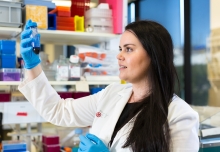
Michael Parker
Alzheimer’s disease is characterised by the failure of cognitive functions such as language, loss of memory and perception of reality. It is estimated that approximately 430,000 Australians live with dementia costing an estimated $15 billion dollars annually. These figures are projected to increase drastically over the coming years, due to our aging population. The predominant strategy to treat Alzheimer’s disease has focused on removal of amyloid plaques in the brain. Over the past 30 years, pharmaceutical companies have poured billions of dollars into treatments that clear the brain of plaques, in the hope that it would stop the damage that is driving memory loss. Despite this, no drugs have succeeded in stopping or reversing dementia, and the few Alzheimer’s disease treatments that have been approved, only ease symptoms rather than altering the course of the disease. We recently developed a new treatment and have generated exciting preliminary data to show that we can successfully remove toxic amyloid without the negative consequences that have plagued drug trials. We now propose to test the ability of our innovative treatment to lower amyloid burden and arrest cognitive decline in mouse models of Alzheimer’s disease.

Andrew Shoubridge
Targeting of host-microbiome interactions to achieve precision in dementia risk reduction
Despite dementia being an important cause of disability and dependency in older age, we are unable to identify those individuals who are at high risk before the development of symptoms. This means we are less able to provide early support, and that opportunities to prevent or delay the onset of disease are missed. Healthy gut microbiology can help to prevent inflammation that contributes to dementia risk. We have shown that features of intestinal microbiology are associated with dementia severity. Our study aims to better understand these relationships by connecting gut microbiology and inflammatory features with clinical signs of dementia in South Australians diagnosed with dementia through the Australian Dementia Network. In addition, we aim to develop strategies to reduce risk and prevent or delay onset, both by informing effective public health measures and through the development of new therapies that target gut microbiology or immune regulation. Our study will also be facilitated by the creation of a collaborative South Australian dementia care group that will integrate the laboratory, clinic, and community. This group will engage with existing and new stakeholders and help to shape an initiative that enhances dementia research and care.

Anna Konopka
Understanding the causes of DNA damage in dementia associated with abnormal TDP-43
DNA carries genes that define any living being. The genes are essential for function of the whole organism, but they are damaged everyday due to normal cellular processes and exposition to toxic agents. Therefore, efficient DNA repair mechanisms are crucial for the proper functioning of genes and the maintenance of healthy cells. Abnormal accumulation of DNA damage actively contributes to neurodegeneration in Alzheimer’s disease (AD) and frontotemporal lobar degeneration (FTLD), the two most common causes of dementia. However, precise mechanism underlining this phenomenon is unknown. In both, AD and FTLD, abnormal protein called TDP-43 is present. Interestingly, recently it was discovered that TDP-43 repairs DNA. Given that DNA is damaged in dementia and TDP-43 does not work properly, defective DNA repair may be a potential cause of the disease. In this project I investigate how abnormal TDP-43 damages DNA in dementia to be able to repair this mechanism and therefore treat dementia. Because damage to DNA targets genes, I also aim to identify these genes. This information will provide better understanding of the causes of dementia and will also pave way for the establishing new therapeutic strategies for dementia.

Bridget Reagan
Improving the communication of dementia diagnoses - A pilot study
Neither communicating nor receiving a diagnosis of dementia is an easy process. Studies have shown that good communication can help to mitigate negative outcomes such as poor treatment decisions and reduced psychological adjustment. Research has highlighted the key features of dementia diagnoses communication that help improve outcomes for people with dementia and carers. Such features include demonstrating compassion, considering how directly to disclose, offering opportunities for questions, providing hope, demonstrating awareness and managing dynamics between people with dementia and carers, and providing written information to support understanding. This study aims to (a) review the strategies in place in three multidisciplinary memory clinics, and (b) pilot and evaluate an intervention to improve dementia diagnoses communication in these clinics. Data collection will involve sampling the experiences of clients, carers, and clinicians at feedback sessions before and after the intervention. Data analysis will involve both comparison of numerical results and an analysis of themes raised by people with dementia, carers, and clinicians pre and post intervention. The results of this study are expected to confirm the benefits of diagnostic communication training and contribute to future development of guidelines in delivering a dementia diagnosis.

Claire O'Connor
Bridging the implementation gap: maximising everyday function for people with dementia
One in 10 Australians aged 65 or over have dementia, a leading cause of progressive disability. The Royal Commission into Aged Care recommends enabling interventions such as occupational therapy and exercise to support ability to do everyday activities, and people living with dementia want access, but these interventions are not being offered in usual dementia care. This research seeks to understand how to overcome barriers to successfully delivering enabling interventions within the real-world setting of existing community aged care service providers using available Commonwealth funding sources. In parallel, the project aims to explore whether meaningful outcomes can be achieved for people living with dementia participating in enabling interventions. In partnership with an advisory group (people impacted by dementia and industry stakeholders), we will: (1) explore current practice (clinical audit); (2) seek national input on strategies for how to deliver enabling interventions within community aged care services; (3) test these strategies and explore program outcomes for people with dementia; (4) develop a national guide on how to deliver enabling programs to support everyday abilities in people living with dementia accessing community aged care services. Outcomes have potential to improve the national landscape of services offered to Australians living with dementia.

Deborah Brooks
Towards better mental health of people living with dementia in residential aged care: Co-design of a performance measurement tool to aid organisational governance
Mental health practices for people living with dementia in residential care are often poor, with an increased risk of prescribing medication for those who experience psychological symptoms and changed behaviours such as agitation. Additionally, psychological, social and person-centred care can be poorly implemented. The COVID pandemic has exacerbated existing concerns about the mental health of residents. However, there is currently no measure to monitor and promote mental health for people living with dementia in residential care.
This study aims to improve current practices and outcomes for people living with dementia in residential care by co-designing a performance measurement tool for use in care facilities. We will ask residents both with and without a diagnosis of dementia, family/care partners and residential care staff, about the key areas that need to be addressed and measured to improve mental health practices and outcomes. We will also seek to gain the consensus of aged care industry, consumer organisations, academics, and clinicians on the quality indicators to be included. We aim to co-design a Mental Health Tool for Residential Aged Care (MHICare Tool) that can eventually be rolled out across residential aged care facilities in Australia to improve mental health practices and outcomes for residents.

Dorothy Wai
Developing potent and brain-permeable peptide therapeutics for Alzheimer’s disease
There remains an urgent and unmet need for novel Alzheimer’s disease therapeutics, with a limited number of drugs currently approved in Australia to treat symptoms of Alzheimer’s disease, and none that are able to slow its progression. One reason that drug candidates are ultimately ineffective against Alzheimer’s disease may be that insufficient drug reaches brain cells from the bloodstream, due to the tight barrier formed by blood vessels within the brain. Our research aims to engineer an Alzheimer’s disease drug that can bypass this barrier and enter the brain efficiently. We have developed HsTX1[R14A], a drug candidate that selectively targets microglia, the immune cells of the brain, by blocking a protein that is overactivated on these cells. This suppresses the inflammatory properties of microglia and promotes their ability to clear toxic proteins that build up in the brain in Alzheimer's disease. By attaching ‘shuttle’ molecules to HsTX1[R14A], which allow HsTX1[R14A] to enter the brain more easily, we aim to deliver a therapeutically effective drug dose to the brain (as tested in a mouse model). Together with its high efficacy and low toxicity, HsTX1[R14A] would be a highly promising lead molecule for development as a next-generation drug for Alzheimer’s disease.

Grace Lidgerwood
Modelling Alzheimer’s Disease using a novel stem cell model of the human retina
Alzheimer’s disease is a neurodegenerative disease with no definitive cause or cure. A common feature of the disease are plaques of protein in the brain called beta amyloid (Aβ) which can appear decades before the first symptoms of dementia are observed. The retina, which is the light sensing tissue of the eye, is an extension of the brain and thus a “window” into the health of the brain. Recent research has found that the Aβ load in Alzheimer’s patient brains correlates with levels detected in the retina, heralding an exciting avenue of clinical research for non-invasive detection of the disease. It is now possible to study the molecular events that underpin Alzheimer’s disease in the laboratory using a patient’s very own stem cells (called induced pluripotent stem cells or iPSCs). Using iPSCs from patients with clinically diagnosed AD, our study aims to create the first lab-based retinal model of Alzheimer’s disease. Using a range of cutting-edge technologies, we aim to develop a robust model that can ultimately be used for drug screening, to identify therapeutics that inhibit or reverse Aβ-mediated damage in the retina. Findings from this study may provide new avenues for Alzheimer’s research and therapeutic discovery.

Helen English
Designing evidence-based creative arts programs to maintain healthy minds in older adults
Keeping active in later life is important for maintaining social, cognitive and emotional wellbeing, and delaying or preventing the onset of dementia. While physical activity can promote wellbeing in older adulthood, not everyone can participate in sports or exercise. Creative arts activities offer a promising, complementary approach to engage our thinking, emotions, creativity and imagination. While engagement in creative activities is linked to beneficial effects on wellbeing, research into the specific effects of creative arts engagement on brain and cognitive health is lacking. This project uses a cluster randomised control trial design to compare the effects of artmaking and songwriting courses on brain, cognitive and emotional processes in healthy older adults. We aim to identify the important ‘ingredients’ of creative activity programs that drive benefits in wellbeing. Findings from this project will inform the development of evidence-based creative arts programs with protective effects on cognitive functioning, emotional wellbeing and quality of life for adults at all stages of ageing.

Janet van Eersel
Pre-clinical development of next-generation tau aggregation-inhibitors for the treatment of dementia
Alzheimer's disease and Frontotemporal dementia are two common causes of dementia, for which there is no effective treatment or cure. In the brains of people with these disorders, abnormal clumping of a protein known as tau is observed. These tau clumps start off small, but over time mature, grow and form large tau tangles. Historically, it was thought that tau tangles cause cells within the brain to die. However, new research suggests that it is the smaller, initial tau clumps which are responsible for this. This has major implications, as current drugs in clinical trials are known to target tau tangles and, by causing them to disassemble, these drugs may in fact cause the release of smaller toxic tau clumps that were safely trapped away.
This project aims to develop the next-generation of tau-targeting drugs which act specifically on the smaller, toxic tau clumps but NOT on tau tangles. We believe this will lead to greater clinical benefits. We will use several newly-developed, cutting-edge technologies that can detect tau clumps with better sensitivity. Promising candidates will then be tested in various models to determine their potential. This will lay the groundwork for, hopefully, future clinical trial testing in patients.
967a.jpg)
Karissa Barthelson
Adult- and childhood-onset dementias: Related causes and related solutions?
Alzheimer’s disease (AD) has been researched for over a century. To date, the complexity of this disease has been difficult to completely capture in animal models. Consequently, treatments originally developed in animals are not particularly effective in all AD cases. To discover alternative AD therapies, a different approach is required.
Dementia is not only a disease of the elderly. 1 in 2,800 Australian babies will develop childhood-onset dementia. This is a significant burden, yet the existence of childhood dementia is not nearly as recognised as AD. Unlike AD, the genetic bases of the childhood dementias are very well defined, and reliably representative animal models exist. There is a large degree of overlap in the brain and behavioural changes between AD and the childhood dementias. Therefore, the possibility arises that the disease- associated mechanisms in the childhood dementias are similar to those in AD.
This study will assess molecular-level similarities between the pathologies of AD and one of the more common forms of childhood dementia, Sanfilippo syndrome. I will study whether treatments targeting these shared pathologies are therapeutic in both conditions. My research program analysing parallel responses between AD and Sanfilippo models should reveal innovative solutions to both dementia types.

Kristie Stefanoska
Master sites of tau phosphorylation as treatment targets for Alzheimer’s disease
Alzheimer's disease is the most common cause of dementia. Current medications provide symptomatic relief but do not alter the mechanisms underpinning it. Thus, treatments that prevent or limit Alzheimer’s disease are still a major unmet clinical need. The progression of Alzheimer’s disease correlates with the abnormal accumulation of a protein called tau. Abnormal accumulation of tau is due to the protein undergoing modification, which causes it to collect with other tau proteins and form larger, abnormal structures in the brain.
Previously, I made the discovery that a few sites on tau – referred to as Master sites, can drive modification of tau. This raises the possibility that inhibiting disease-promoting Master sites could provide a novel approach to intervene and prevent modification of tau, and thus mitigate molecular processes underlying disease. I will use animal models recapitulating Alzheimer’s disease to address the role of tau Master sites. This will include interrogation of Master sites for their function in cognitive processes and may provide the molecular basis for designing new treatment strategies and/or biomarkers for the identification and prevention of tau-related disorders. This research has the potential to provide a new novel disease-limiting treatment, which would significantly benefit individuals living with tau-mediated dementia.

Leah Bauchamp
Protein phosphatase 2A methylation as a therapeutic target in Alzheimer’s disease
The impact Alzheimer’s has on our minds and lives is evident to all of us, and we are in desperate need of drugs that are safer and more effective. There are failures in biochemical processes in the Alzheimer’s disease brain, and as this disease progresses there is an accumulation of a protein called tau that becomes toxic. Tau is a protein that we need throughout life, however, in Alzheimer’s disease it changes and becomes ‘sticky’, causing the protein to aggregate in our brain cells. Over time these protein aggregates give way to a range of toxic pathways that build up over time resulting in what we know as dementia.
This research will develop strategies that correct this biochemical failure leading to toxic tau aggregates. Firstly, we have designed several new drugs that will promote the stability of ‘good tau’, and we have designed a compound that can reduce the dynamic process that turns ‘good tau’ into ‘bad tau’. This work aims to create new therapies that specifically target tau and help to reduce the burden of these protein aggregates in the brain leading to better brain health as we age.

Lidia Engel
The COCOON research project: incorporating Carer Outcomes in COst-effectiveness analyses Of dementia iNterventions
Providing informal care to a person living with dementia is not only associated with significant costs but there can also be significant quality of life impacts for informal carers. However, these impacts are rarely considered when assessing the cost-effectiveness of dementia interventions, leading potentially to sub-optimal resource allocation decisions. The aim of the COCOON research project is to advance the methods used when assessing the cost-effectiveness of dementia interventions by incorporating carer outcomes.
In this Fellowship, I will develop, with input from an advisory group, a new dementia-specific questionnaire to measure quality of life of informal carers, which will be tested for its appropriateness and performance in informal carers. I will then develop a way of scoring this new questionnaire that will account for the fact that some domains of quality of life are valued more than others. In the final part of the Fellowship, I will assess how carers’ quality of life can be combined with care recipients’ quality of life, by obtaining preferences from the Australian general population in terms of whether they should be weighted differently. Findings from this research project will enable the inclusion of carer outcomes in future cost-effectiveness analyses, leading to more equitable and efficient resource allocation decisions.

Liviu-Gabriel Bodea
Rejuvenating microglia to alleviate Alzheimer’s disease
The risk of developing Alzheimer’s disease (AD) increases with age. Although we know the general characteristics of the AD brain, the development of effective treatments against the mechanisms leading to AD are still lacking. Our research will focus on investigating ways to improve the efficiency of the brain cell types known as microglia to clear AD-specific pathological signs. Microglia have beneficial roles that decrease with age, when, in turn, become toxic for the surrounding cells. We aim to use animal models that were experimentally induced to mimic AD and identify how microglia shift their roles due to age and AD. For this, we will utilise in mice an extremely sensitive novel technique recently developed by us and validate these results on brain samples from AD and healthy humans. In addition, we will repurpose a drug currently tested in other diseases and that can eliminate aged microglia, allowing us to investigate if the removal of aged cells improves the AD pathology. Taken together, these results will help us understand how AD progresses and to develop a potential novel treatment strategy against the disease.

Louisa Smith
Rainbow Connections: Co-designing training and engagement resources to help community visitors to make and maintain social connections with LGBT+ people with dementia
Lesbian, Gay, Bisexual and Transgender (LGBT+) people with dementia have diverse and complex support needs. Previous research shows that after lifetimes of discrimination, LGBT+ people with dementia often do not have families they can rely on and do not want to use health or aged care services because of bad experiences in the past. This lack of access to supports makes volunteer community visitors crucial to the health and wellbeing of LGBT+ people with dementia. The national Community Visitors Scheme (CVS) — funded by the Australian Government — supports volunteers to foster friendship, companionship and connections by visiting socially isolated older LGBT+ people. But the growing numbers of LGBT+ people living with dementia present a particular challenge for the CVS. Organisations that support community visitors for LGBT+ older people around the country recognise that suspected or diagnosed dementia often makes visiting more challenging. Supporting the capacity of visitors to continue visiting LGBT+ people with dementia are the goals that drive this project. This project will develop resources to support community visitors to make and maintain connections, friendships, and companionship with LGBT+ people living with dementia. The implications for this project are that it will not only increase capacity of community visitors to LGBT+ people with dementia, but also provide resources for all community visitors visiting people with dementia around Australia.

Louise Neale
Understanding relationships between neuroimaging markers and culturally relevant protective factors in Aboriginal communities: A way to enhance dementia prevention and diagnosis?
Research has shown higher dementia rates in Aboriginal and Torres Strait Islander communities compared to the broader population; however, there has been no study on underlying brain changes. Furthermore, lifecourse exposures (e.g., education, work opportunities) may be protective even when dementia-related disease/injury are present; yet little is understood about these relationships for Aboriginal and Torres Strait Islander people and how they predict cognitive function over time. This study aims to investigate relationships between brain structure and protective factors that contribute to healthy ageing and delay/prevent dementia; and will follow-up participants to predict cognitive outcomes. The project will involve co-developing a culturally relevant measure that captures protective lifecourse exposures. Two-hundred older Aboriginal and Torres Strait Islander people will then have Magnetic Resonance Imaging (MRI) scans. MRI brain structure measures will be examined in relation to the protective lifecourse exposure measure, to understand how they are related. This project will also develop a way to assess cognition via telephone or video conference, to easily follow up MRI participants 1 year later and investigate how the brain and protective factors predict cognitive decline. This project will inform culturally meaningful dementia prevention strategies and enhance dementia diagnosis for Aboriginal and Torres Strait Islander peoples.

Lyn Phillipson
Communities for dementia
Across Australia and worldwide, Dementia Friendly Communities (DFCs) have emerged as both a social movement and a policy response to enable community dwelling people living with dementia and their care partners to live well. However, whilst DFCs have been promoted as an effective approach to support wellbeing, there is a lack of available data to test this. This research will support the development of a national evaluation framework and the conduct of local case studies to establish the factors that produce positive outcomes for people living with dementia and their carers in Australia. It will also establish the resources needed to create and sustain DFCs. The multi-methods study will support: co-design of an Australian DFC Evaluation Framework and indices, as well as piloting and use of the framework to develop six in-depth case studies. Evidence will be synthesised across cases to assess impact of the different models, and what sustains their outcomes. Results will support understanding of what works and what doesn’t work, with respect to designing, implementing and rolling out further DFCs in different community locations.

Marina B Pinheiro
A physiotherapy-led telehealth and exercise intervention to improve mobility in older people receiving aged care services: an effectiveness and implementation randomised controlled trial (The TOP UP Study).
Dementia results in cognitive decline, reduced balance and poor mobility. People living with dementia fall twice as often and are three times more likely to break bones and die. A physiotherapist can help older people improve their balance and walking. Older people need to do 2 hours of balance and strengthening exercise per week to reduce their falls risk and maintain their level of independence. This is a challenge in aged care as there are not enough physiotherapists and staff to assist older people with dementia to exercise safely. COVID-19 has exacerbated the situation by restricting physiotherapist’s ability to visit people. Telehealth is emerging as a new way to allow people living with dementia to ‘see’ their physiotherapist online.
We aim to evaluate the effect and acceptability of a telehealth physiotherapy programs on mobility and falls in people living with dementia. We want to understand how to use technology to improve the quality of life for this vulnerable population.
If our trial is effective, we plan to roll the program out to the aged care industry and assist older people living with dementia to maintain their function and independence for as long as possible.

Marina Cavuoto
The influence of the Aquaporin-4 gene on the relationship between poor sleep and preclinical dementia: A multi-cohort study.
Poor sleep can contribute to dementia by disrupting the brain’s ability to remove toxic waste products that contribute to the development of Alzheimer's disease and other causes of dementia. The Aquaporin-4 (AQP4) gene plays an important role in the capacity of the brain to “flush out” waste. However, little is understood about the role of the AQP4 gene in the association between sleep and dementia. This could be crucial in identifying who would benefit most from sleep treatments designed to prevent dementia.
This study aims to investigate whether people with different variants of the AQP4 gene are more at risk of cognitive decline and early dementia biomarkers in the face of poor sleep. This will be done by looking at genetic sequencing in three different cohorts and comprehensively assessing sleep, and early dementia biomarkers, as well as cognitive assessments over time. The results of this research will identify whether certain people are at higher risk of negative brain health associated with poor sleep.